Introduction
“Why the economy of some countries prospers every year while others struggle?”. For many years, this question has been the main interest point of economists. Since this question came up, many economists have made research to help find answers. Although there are different opinions about this topic, many believe that the main factors that influence economic growth are human capital, physical capital, technology, and so on. Hence, all these points are implemented through competitive institutions and regulations. Therefore, it is not possible to describe the economic growth and living standard of a country without considering its institutional framework.
Institutional framework refers to all the adjustments and regulations done by the government to decrease transaction costs between economic players and channel investments to productive sectors. To emphasize adverse impact of the transaction costs, we could look at one case: for example, when there is a well-constructed property right system in a country, then people (investors) don`t need to incur additional costs (contracts) to for safety of a place or land. Instead, they can invest these funds in more effective ways.
Institutions differ between societies by virtue of their formal methods of collective decision-making (autocracy versus democracy) or their economic institutions (the set of contracts available to businesspersons, property rights, entry barriers, and etc.). The institutions can lead the country to both higher macroeconomic performance and lower GDP depending on the quality, development, formation, and implementation of institutional reforms. Most of the developing countries have lower-quality institutions, which restrain them from prospering and lead them to inefficient solutions while developed countries enjoy high living standards thanks to the improved institutional structures.
The post-soviet countries
In the last decade of the 20th century, the map and economic policies of the region have changed significantly due to the fall of the Soviet Union. Although 15 countries got their sovereignty from USSR, some of them have been under the influence of Russia even after the independence. Therefore, the economic and political situations of these countries were quite similar at the first period of independence. But later, appropriate reforms and structural system changes of several of the selected countries caused these similarities to weaken and be separated from the rest of the group (Latvia, Estonia, and Lithuania). But the rest are still struggling with the political environment (corruption control, dictatorship, etc.) remaining from the Soviet period.
During the Soviet period, the main purpose of the government was trying to make the countries` economies more dependent on central governance and later deepen this dependency. Generally, this process was carried out intentionally by separating resources and the production process. As an example, if cotton was grown in one country, it had to be converted into final goods in another country. In consequence, they would not survive in the globalizing world on their own. That is why most of these selected countries struggled with a lot of problems by means of an economic perspective after gaining sovereignty. While post-soviet countries thought about the way to accelerate transition after collapsing USSR, western countries had already decided the role of institutions in economic growth.
Aim
This article aims to contribute to the literature in examining the effects of institutions on macroeconomic performance for the post-soviet countries. The paper is intended to describe the relationship by using the main pillars of institutions as independent variables and show how a change in these variables would affect the economic growth (GDP per capita).
The rest of the paper is structured as follows: First, we provide information about the literature review of variables that will be used in the model. Then methodology and result of the model are presented, respectively. The final part draws conclusions.
Literature Review
One of the interesting issues relating to countries’ development is seeking the reason for the growth rate of the states despite their similar pasts. Some scientists explain it with economic factors while others try justifying it based on the institutional factors. So, different growth rates across countries have always been a source of interest for researchers in economic sciences. Though we cannot exactly measure why some countries are well-developed while others are poor, there are some undeniable facts that affect the results. Growth is achieved through the accumulation of human resources, physical capital, and access to new technology, according to standard growth theories. But new studies and experiences show that high institutional quality is also one of the main reasons for cross-country growth inequalities and different development levels. To analyze the effect of institutions, it is important to first emphasize what we mean by institutions. A well-structured definition of institutions is given by D. North as “humanly devised constraints that structure political, economic and social interactions”. As society is formalized based on the three mentioned activities, it creates a sense that institutions really matter.
Some academicians showed the power of institutions by comparing “relative countries”. For instance, Acemoglu et al. took Communist North Korea and free-market South Korea as an example in their research. Prior to 1945, the economic characteristics and productivity of both nations were almost equal. South Korea is now over ten times wealthier than North Korea. The gap between these two countries can be explained through the choice of economic and political-institutional systems in their ex-post economic trajectory.
A survey by Irena Benešováa and Luboš Smutka (2016) examined the GDP of selected post-Soviet countries for the period ranging from 2000 to 2014. The prior objective was to explain the improvement in the economy of these countries from the standpoint of mutual co-operation. According to the results, it was noticed that GDP experienced a significant increase throughout the years. Russia and Kazakhstan were the ones that dominated in this growth over the other countries in this region. Expansion in the price of mineral resources, having a wide range of foreign investments and finally gross fixed investments, were the most important factors which contributed to that growth. As opposed to this, there was a negative elasticity between the factors- the balance of external relations, the value of resources, and GDP.
The survey of “The Impact of Institutional Quality on Economic Growth: Panel Evidence” (Lazarus Z. Wanjuu1 and Pierre le Roux1, 2017) was to estimate the effect of economic institutions on economic growth over 35 Asian countries for the period 1996-2012. This impact was shown by using the following indicators: control over Corruption control, Government effectiveness, Political stability, Rule of law, Regulatory quality, and Voice and Accountability. The result of this research on those variables demonstrated that all of these six variables imposed a positive effect on the economic growth of those Asian countries.
The next reference is the article “Institutions and Economic Growth: Does Income Level Matter?” (2018) by Aziz, Nusrat, and Ahmad, Ahmad H. This survey refers to both cross-sectional and panel data for 126 and 106 countries, respectively. The article mainly covers how institutional variables influence the GDP and GDP per capita of low-income, middle-income, and high-income countries for the period 2000-2009. In consequence, corruption control, and conflicts harm economic growth. However, corruption control has an insignificant impact on low-income countries. In addition to the factors, which negatively improve the countries` growth, democracy level has a significant and negative effect on the high and low-income countries; in the meanwhile, polity improves the GDP of middle-income countries and contrasts other types of countries. Conflicts also have mixed effects; hence, this variable indicates that the armed conflicts have a significant impact only on low-income countries. Nevertheless, for the others it is insignificant. Beyond these direct effects, capital, human and physical capital have a positive impact on economic growth. Henceforth, the division of the countries into three categories assists to observe the significance of institutional variables through the economic growth of the countries.
YILDIRIM and M.F. GOKALP investigated (2016) institutional framework and macro-economic performance for the period 2000-2011. In this research, they have selected 38 developing countries as a sample and used the “panel data analysis” method to examine the relationships. The result shows that certain indicators of institutions (such as regulations on trade barriers, the integrity of the law system, restriction of foreign investments, etc.) have a positive effect on the macro-economic performance of the developing countries whereas the other variables (government expenditures, civil freedoms, political stability, judiciary independence, etc.) have a negative influence.
In recent years, there has been a wave of interest in globalization-related topics, including financial globalization. The consequences of eliminating capital controls were rekindled by a string of financial crises in the 1990s, prompting many analysts to rethink the benefits and drawbacks of financial liberalization. (Kaminsky and Schmukler, 2001a, b, 2002; Schmukler, 2003). On the other hand, Stlutz (1999) explains the advantage of financial globalization as following: “Financial globalization lowers the cost of equity capital because of lower projected returns to compensate for risk and lower agency costs.” However, it is often asserted that to benefit from more transparent cross-border financial flows, financial markets must provide adequate legal and operational frameworks.
Chinn and Ito investigated the relationship between capital account transparency, financial growth, and the legal/institutional framework (2002). They found that financial systems with a higher level of legal/institutional growth benefit more from financial globalization than those with a lower level of development. Furthermore, the beneficial impact of legal/institutional development appears to be guided mainly by shareholder rights and accounting standards. A higher level of bureaucratic efficiency and law and order, as well as lower levels of corruption control, can amplify the impact of financial opening in fostering the growth of stock markets. They also discovered that the ultimate level of finance-related legal/institutional advancement raises stock market trading volumes and boosts the impact of financial transparency in emerging market economies.
Dreher (2006) made research about Globalization and its effects on economic growth and poverty level. For this purpose, he investigated 123 countries for the period covering 1970-2000. In the survey, the author concluded that globalization has a positive impact on economic growth.
Considering economic globalization, one of the problematic issues is the crowding-out effect (Agosin and Mayer, 2000.). When transnational companies with enormous financial resources enter the market, they drive out small local firms. On the other hand, crowding out insists local companies run more efficiently. So, it is not a problematic issue because in a strictly economic sense it will boost market competitiveness. But this effect occurs not only because of globalization’s results but also the “structure” of inflow of foreign direct investment (FDI) to the recipient country. In some markets/countries, FDI can also positively impact institutions. S. JAVADOV (2018) examined the relationship between institutions (transparency) and FDI in selected post-communist countries and concluded with the positive effect of FDI on transparency.
Data
Throughout the paper, the analysis is meant to describe the relationships between institutional structure and economic performance of the post-soviet countries. For this purpose, an investigation is made based upon a country sample consisting of 7 post-soviet countries. The article did not include Latvia, Lithuania, and Estonia (EU member states). In 2004, They achieved their long-standing strategic goals and became members of both NATO and the European Union. Due to their long-term strategies, high economic and political stability, and quick transit from the dependency of Russia to totally independent states, they are highly differentiated from the rest of the post-soviet countries. That is why the survey skips these countries. Collecting data is especially difficult for Tajikistan, Uzbekistan, Turkmenistan, Moldova, and Armenia. Hence, these countries’ figures have not been utilized for research because of lack of the data and transparency. The paper contains data of the following countries: two from Transcaucasia (Azerbaijan and Georgia), two from Central Asia (Kazakhstan and Kyrgyzstan), and three countries from Eastern Europe (Russia, Ukraine, and Belarus). All the countries looked at used to be or still are connected to the main power of the region – Russia with political and economic ties.
In the application part of the study, the research investigates the maximum 27 years period covering years between 1993-2019. The main reason why all data are gathered after the 1990s is that most of these countries were liberated after the collapse of the Soviet Union, and starting from that point, they became independent and began to keep statistics on their own.
In the estimation, a great number of variables are utilized as not only macro-economic performance but also institutional indicators. Similar investigation was carried out by A. YILDIRIM and M. F. GOKALP (2015). They took property rights as an independent variable in their analyses and as a result it has an insufficient effect on GDP. That is why we take corruption control as the main variable, which is one of the main pillars of the institutional framework instead. Consequently, the growth rate in the economy is described as the dependent variable in this circumstance.
The theoretical framework encompasses institutional factors, which consist of political globalization, Internet per user, Human Development Index, political globalization and corruption control, also other factors such as trade openness, Foreign Development Index (% of GDP), and total natural resources rent (% of GDP) that have a different impact on the GDP per capita of selected countries. The main resources used to get data are The World Bank (Internet per user, Foreign Direct Investment, Trade openness, and Total natural resources rent, actual GDP per capita), KOF Globalization Index (Political Globalization), The Worldwide Governance Indicators (Corruption control), and Human Development Reports (HDI). After the regression analysis, we notice that the model is generally suitable for all countries. It implies that about 90% of the variation in the economic growth (Y) of seven Post-soviet countries is explained by changes in the independent variables. The confidence level has been adopted as ninety-five percent. In consequence, efforts of the individual variables have different results for Y. There are two hypotheses to evaluate the significance of the model in accordance with the ANOVA table:
H0: The model is unnecessary (null hypothesis, which indicates that all the coefficients are zero).
H1: The model is necessary (alternative hypothesis, which indicates that at least one of the coefficients is not equal to zero).
The Results
Thereby, the indicators of the countries are explained in more details below:
Russia
As it is seen in Table 1, the total variation in economic growth (Y) is explained by the coefficients of determination, R², and adjusted R², which nearly account for 93% and 90% respectively. In general, regression model is insignificant in F-test (p-value ≈ 1.46 (>0.05)). That is why all the variables should be mentioned individually. FDI, Internet per user, and almost HDI have a significant impact on the economic growth of Russia (Table 2). Contrariwise, results show that political globalization and trade openness have the least contribution to the development of the country. Eventually, this circumstance can be evaluated as formal institutions mainly do not lead to an increase in GDP per capita. The result shows that the one-point rise in FDI and Internet per user causes respectively an increase of 1964 and 226 points in economic growth.
Table1
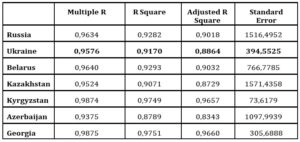
Table 2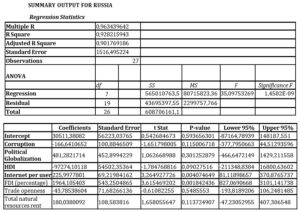
Ukraine
The model also seems quite acceptable for Ukraine since R square is about 91.7. However, the significance of the model is less than Russia. It means, generally, the variables do not distribute normally. It is observed that total natural resources rent (it creates a contradiction with Russia) and Internet per user are in confidence level and they have a positive impact on the predicted variable (Table 3). Obviously, corruption control, political globalization, and HDI have a minor effect, whereas their impact is more tremendous on the other countries’ economies.
Table 3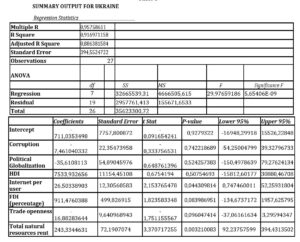
Belarus
One of the Eastern European countries – Belarus demonstrates high (0.9390) R squared and its adjusted form. Even though the significance of the whole formula is not accepted, the model is more suitable than other selected region countries. If we analyze the indicators separately, we can notice that all factors have a positive effect, except the Internet per user. In the meanwhile, Internet per user and HDI are in the acceptance area. Henceforth, it can be said that the importance of governmental institutions is much more than the trade openness and natural resources rent, as shown in Table 4.
Table 4
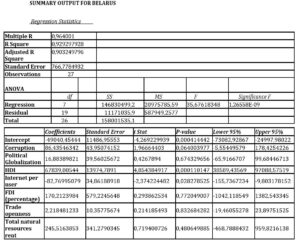
Kazakhstan
The relationship between dependent and independent variables is sufficiently higher. Institutions and the other three variables together contribute less importance to the growth of Kazakhstan. Nevertheless, only corruption control, HDI, and political globalization are not in the confidence interval (Table 5). Kazakhstan is a unique country where trade openness is not in the rejected area. Internet per user and Foreign Direct Investment is accepted the same as Russia. The main difference in the impacts of the variables between Kazakhstan and Russia is that coefficients of Internet per user and Foreign Direct Investment for Kazakhstan turns out to be less than Russia.
Table 5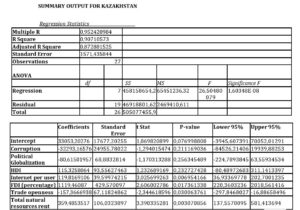
Kyrgyzstan
Compared to the other selected countries, the model is more suitable for forecasting the future of Kyrgyzstan. The impact of explanatory variables is distinguishable from other countries. Thus, just two of them – corruption control and HDI contribute information in the prediction of Y (Table 6). Corruption control is the only variable selected for this research that donates a significant positive impact on economic growth.
Table 6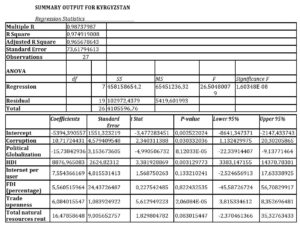
Azerbaijan
R squared also assists to say that model fits Azerbaijan. F-test shows that as for the other countries, the formula is not admissible because of the lower significance level. That is why variables should be examined one by one. Thus, HDI and total natural resources rent can be accepted as the result represents a p-value below 0.05 as mentioned in Table 7. This conveys that one-point increase in HDI leads to a rise of nearly thirty-nine points in the economic growth of Azerbaijan.
Table 7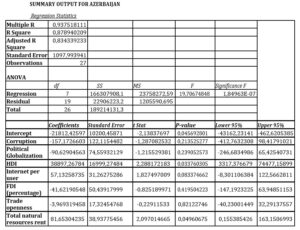
Georgia
The model is more appropriate for Georgia than Azerbaijan although both are in the same region – Transcaucasia. Only political globalization is not in the rejected area of the hypothesis testing. Furthermore, this variable has a negative impact on economic growth (Table 8). However, this cannot be interpreted properly.
Table 8
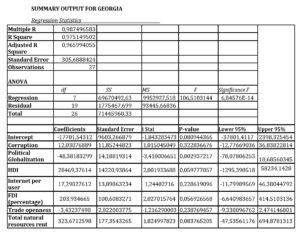
Conclusion
As a result of the investigation, it is noticed that the institutional variables almost serve to act differently for each country. Broadly, the variable of Internet per user has significant and positive feedbacks to the economic growth of most countries. On the contrary, as an outcome of the study, trade openness and corruption control are less important for the development of the economy. As for the other variables, their effect varies not only by regions but also by countries. It should be noted that factors that influence economic growth (GDP per capita) differ from country to country from the standpoint of leaving either positive or negative impact. Regardless of the indicators covering ninety percent of the variation that is caused by the factor we have chosen, only FDI and Internet per user have a confident explanation, which only later could be considered as an element of the institutional framework from the standpoint of information accessibility. Obviously, as a successor and the biggest country in the post-soviet region – Russia possesses an enormous market in which some other variables that we have not considered exist. As an idiosyncratic country for further research, investigating the other institutional variables would be plausible as well.
The rest points that have to be focused on are the other causal effects. Henceforward, one of the institutional variables – political globalization has only a remarkable negative influence on the GDP per capita of Georgia that practically could not be explained. While focusing on the impact of indicators on economic growth, it would be better to shed light on the issue of multiculturalism factor for the countries, especially for Azerbaijan. One of the main reasons why political globalization leaves its insignificant impact on this country can be related to the fact that the multiculturalism index is not mentioned as an element of globalization. For that reason, it is highly recommended to consider this point in more detail for future research; indeed, some countries, like Azerbaijan, have taken drastic steps on the way to increasing multiculturalism level.
When it comes to corruption control, the result of the research displays that it has a significant effect on the economy of Kyrgyzstan. One of the interesting aspects of the study contrary to popular belief corruption control affects the economy positively rather than negatively. It is likely that there might have been some other factors influencing this result.
Human Development Index possesses mixed effects on the economy of the countries. However, it imposes a positive effect on the GDP per capita of Belarus, Kyrgyzstan, and Azerbaijan, at the point where HDI is accepted. In consequence, an increase in HDI gives rise to an expansion in the economic growth of those countries.
One of the institutional variables – Internet per user is within the confidence level of the three countries (Russia, Belarus, and Kazakhstan). This indicator only harms the economic growth of Belarus as opposed to the rest. There is also another crucial fact that the variables of Foreign Direct Investment and trade openness have an essential impact, which brings about the same contribution – positive on the GDP per capita of just these two countries – Russia and Kazakhstan. Finally, the total natural resources rent indicator acts in a way to help the economy of Ukraine, Kazakhstan, and Azerbaijan, to progress efficiently.
Limitations
Since HDI exhibited a strong relationship with economic growth, lack of data of this variable can be considered as a limitation. On the other hand, we assume the HDI variable would be much stronger if it contained IQ indicator. Because IQ is a much more punctual variable from the perspective of institutional indicators. Another obstacle is related to the transparency of data which has been a problem in soviet heritage from the beginning.
Moreover, for further research, we consider that including long effect of the institutions and relationship amongst responding variables (for instance, FDI and corruption control) for the selected countries would be reasonable.
References
- YILDIRIM and M. F. GÖKALP, 2015. “Institutions and Economic Performance: A Review on the Developing Countries”. Issue ICEF 2015, p. 347 – 359.
- Acemoglu, Daron & Johnson, Simon & Robinson, James A., 2005. “Institutions as a Fundamental Cause of Long-Run Growth”. Philippe Aghion & Steven Durlauf (ed.), Handbook of Economic Growth, edition 1 ed. s.l.:Elsevier.
- Aghion, Philippe & Howitt, Peter, 1992. A Model of Growth through Creative Destruction,. pp. 60(2): 323-351.
- Aziz, Nusrate and Ahmad, Ahmad H, 2018. “Institutions and Economic Growth: Does Income Level Matter?”. Volume MPRA Paper No. 83684.
- Brunetti, Aymo, 1997. Political Variables in Cross-country Growth Analysis, Journal of Economic Surveys. pp. 11(2): 163-190.
- DOCQUIER, F., 2013. “Identifying the effect of institutions on economic growth”.
- DREHER, A., 2006. “Does globalization affect growth? Evidence from a new index of globalization”. pp. 38(10):1091-1110.
- Irena Benešováa and Luboš Smutkaa, 2016. The post-soviet countries –development and structure of economy: Is there any potential for future regional integration?. Volume 1877-0428.
- JAVADOV, S., 2018. Does FDI Affect Transparency in Post-communist Countries?. pp. 4(58): 254-266.
- Knox, C. and Janenova, S., 2019. “The e-government paradox in post-Soviet countries”. 32 No. 6( 600-615).
- Menzie D. Chinn, Hiro Ito, 2006. “What matters for financial development? Capital controls, institutions, and interactions”. p. 163– 192.
- North, Douglass C.,1990. Institutions, Institutional Change, and Economic Performance.
- Saima Nawaz, Nasir Iqbal and Muhammad Arshad Khan, 2014. The Impact of Institutional Quality on Economic Growth. Volume 53, No.1
- Wanjuu, L. & Le Roux, P., 2017. ‘Economic institutions and economic growth: Empirical evidence from the Economic Community of West African States’. Volume 2222-3436, (Print) 1015-8812.










